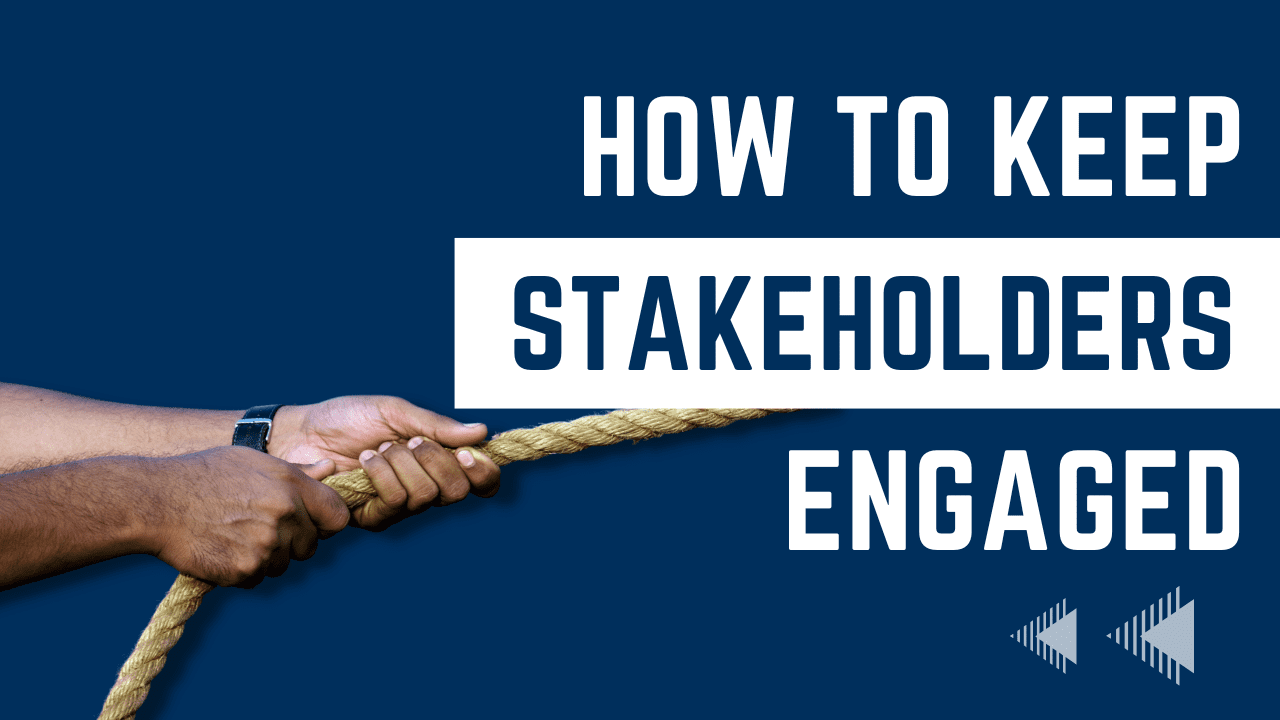7 Ways To Keep Stakeholders Engaged In Salesforce Projects

How do you keep stakeholders engaged when managing Salesforce projects?
Do you ever feel it’s a real challenge to keep your stakeholders engaged during Salesforce projects? You’re not alone!
It can be challenging to ensure everyone is informed, on the same page, and driven to reach the end goal. However, with solid communication skills, an effective project management system, and realistic expectations, you’ll find that engaging stakeholders can be more accessible than expected – enabling better collaboration and improved project success.
In this blog post, we’ll look at some key ways that Salesforce Admins can ensure their stakeholders remain enthusiastic throughout the life cycle of every project.
1. Define the Project’s Purpose and Objectives
Defining the project’s purpose and objectives is essential to keeping stakeholders engaged in a Salesforce project. When everyone involved in the project has a shared understanding of what it is supposed to accomplish, they are more likely to stay on track and work collaboratively towards the goal. Without setting clear objectives upfront, stakeholders may start diverging in their expectations and working towards different goals, ultimately leading to frustration and confusion.
A deliberate effort should be made to take the time and sit down with stakeholders to discuss and agree on the project’s purpose and objectives before any work begins. A comprehensive discussion should cover every aspect of the proposed Salesforce implementation, including scope, timeline, budget, and resources needed for success and any potential risks or obstacles that could arise during implementation. This helps build a system of accountability amongst all involved parties, which encourages them to stay focused on achieving the goals. A collective agreement around the project’s purpose also establishes trust between stakeholders, allowing for smoother communication throughout development.
By engaging stakeholders at this early stage of planning, you can ensure that everyone is on board with both short-term and long-term expectations for implementation and adoption throughout the project’s entire lifecycle. This will clarify everyone’s roles and responsibilities while considering potential changes or modifications that need to be addressed during later stages.
Overall, it is critical for successful stakeholder engagement in a Salesforce project to define its purpose and objectives upfront so that everyone involved is working towards a common goal. This will help ensure smoother communication throughout development while avoiding unnecessary delays or issues arising due to misaligned expectations throughout different phases of implementation.
2. Communicate Regularly
Communicating regularly with stakeholders is essential to keeping them engaged in a Salesforce project. Regular communication helps to build trust between the project team and stakeholders, which can help keep everyone on the same page. When stakeholders are kept informed of project progress, they are less likely to be surprised by unexpected changes or delays. This ongoing communication also ensures that stakeholders stay involved in decision-making, allowing them to provide feedback and input as needed. Furthermore, regular communication helps to build relationships between the project team and stakeholders. This way, any problems or issues can be quickly identified and addressed, and decisions can be made promptly.
Moreover, regular updates on the project’s progress allow stakeholders to feel more connected with the team’s work and better understand how their input helped shape the result. This can increase overall stakeholder satisfaction with the project and lead to increased customer loyalty over time. Additionally, transparent communication regarding what successes have been achieved or challenges have been overcome can help increase morale among team members and show that each person’s contributions make a real difference.
In conclusion, regular communication is crucial to keeping stakeholders engaged in a Salesforce project. Not only does it foster trust and accountability among all parties involved, but it also provides an opportunity for everyone to gain insight into how their efforts contribute towards achieving success for both the customer and the business. For this reason, it is essential for businesses utilizing Salesforce projects to ensure that their teams prioritize establishing consistent lines of communication with their critical stakeholders from start to finish.
SNAG THESE EMAIL TEMPLATES

200+ project management templates to help you get organized and increase your productivity!
Are you tired of wasting time writing the same email messages repeatedly?
I know your time is valuable, so I’ve created email templates specifically for Salesforce Admins to help you manage your Salesforce projects more efficiently.
Use these templates as a starting point or adapt them to fit your own needs. And you can cut and paste them into whatever email system you need.
Stop wasting time on menial tasks and start managing your projects more effectively.
Get access to a vast library of email templates to painlessly manage the entire project lifecycle!
3. Get Feedback
Feedback from stakeholders during a Salesforce project is critical to keeping them engaged throughout the process. Not only does it give stakeholders a feeling of investment in the project and its outcome, but it can also provide critical insights into potential issues or areas that need improvement. By asking for feedback during each stage of a Salesforce project and engaging with stakeholders to discuss their views, the team can work together to develop solutions and strategies that meet their needs. This also creates a collaborative environment where all stakeholders can voice their opinions and contribute to the project’s success.
Feedback from stakeholders can be particularly beneficial when deciding how best to deploy resources or identify potential risks associated with specific strategies. This input can reduce wasted time and effort by ensuring that resources are used to benefit everyone involved in the project. Additionally, by taking into account feedback from stakeholders, teams can identify particular areas where they can make improvements or changes more quickly, which could ultimately lead to improved outcomes for all involved.
In addition, getting feedback from stakeholders helps create a sense of trust between them and those leading the project; this is especially important for long-term projects where relationships between different parties must be nurtured over time. These relationships are essential for successful projects as it helps ensure that those involved work together towards common goals rather than competing against one another. Furthermore, by having an open dialogue with stakeholders throughout each stage of a Salesforce project, teams can address any concerns they have in real-time and come up with proactive solutions before things potentially go wrong down the line – something which could ultimately mean the difference between success and failure.
SNAG THESE FREE RESOURCES!

Struggling to Manage Your Salesforce Projects?
Master Project Management With Our Expert Resources for Salesforce Admins.
Check out some of these FREE RESOURCES, templates, ebooks, and courses to take your project management skills to the next level and take control of your Salesforce career!
4. Make Them Feel Included
Making stakeholders feel included in a Salesforce project is essential to keep them engaged. It’s important to remember that the success of a Salesforce project depends not only on technical issues but also on people, which includes the stakeholders. When stakeholders are involved in the decision-making process and given regular updates on the project’s progress, they will be more likely to stay engaged and contribute their expertise. This also helps build trust between them and the project team.
At a minimum, stakeholders should be invited to attend meetings (virtual or otherwise) to discuss progress, challenges, and solutions. They should be able to ask questions, provide feedback, and be heard. Being given access to reports about key performance indicators (KPIs) can also help them understand how the project is performing against expectations and what changes might improve results.
A great way for stakeholders to feel included is through gamification activities or apps designed specifically for their involvement with the project. This could involve designing processes or checking off tasks accomplished as part of a larger goal. Additionally, recognizing their contributions publicly within the organization can make them feel valued and respected by their peers.
When stakeholders feel like they are part of a team working toward common goals instead of being told what needs to be done without input or feedback, it will create an environment that encourages participation throughout the life of a Salesforce project. This engagement will lead to smoother implementation, faster results, greater creativity with problem-solving techniques, increased collaboration among team members, and ultimately greater satisfaction with everyone involved with the project’s outcome.
5. Address Their Concerns
Addressing the stakeholders’ concerns in a Salesforce project is critical to keep them engaged. If their needs and opinions are left unaddressed, stakeholders may become uneasy about the project, decreasing their involvement. When stakeholders feel that their needs and opinions are not being heard, they may withdraw from the project altogether, leaving it incomplete or unable to move forward.
In addition, leaving the concerns of stakeholders unaddressed can cause them to become disconnected from the team, making any future cooperation more difficult. This disconnection could result in a lack of trust between the stakeholders and other team members, making it hard to work with each other. Moreover, any information shared between stakeholders and team members may be overlooked if there is a lack of trust. As such, addressing stakeholder concerns as soon as they become known can help foster an open communication environment among all participants in the project and ultimately help ensure its success.
Addressing stakeholder concerns allows for better understanding between members of the team and those involved with the project directly. By creating an atmosphere where questions can be asked and problems discussed openly, everyone on board will better grasp what is expected from each member, including goals for completion, timelines for deliverables, ways for tracking progress, etc. This helps create alignment throughout all levels of involvement concerning meeting deadlines and expectations set forth by those not directly participating in day-to-day operations but still connected to or invested in the project’s outcome.
Finally, addressing stakeholder concerns helps keep everyone involved accountable for their actions which contributes significantly towards keeping stakeholders engaged in a Salesforce project. When issues are identified early on through discussion with those involved with it directly or indirectly -and when those issues get resolved quickly – it shows that everyone takes ownership over their responsibilities while also committing themselves towards achieving success collectively. All this serves as added motivation for everyone involved, keeping them focused on completing projects successfully while staying engaged every step along the way!
6. Be Open to Their Ideas
Being open to stakeholders’ ideas in a Salesforce project is essential for keeping them engaged. Stakeholders feel valued and appreciated by listening to their suggestions and allowing them to provide input. This creates a sense of ownership and commitment, which can be critical in driving successful results. Additionally, considering their ideas can lead to more creative solutions that may not have been considered before. This could result in better solutions tailored to the stakeholders’ needs or offer greater efficiency and cost savings.
Furthermore, when stakeholders are engaged in the project, they will be more likely to help problem-solve should any issues arise throughout its duration. Suppose stakeholders feel their contributions are being considered throughout the process. In that case, they will be more likely to stay actively involved in providing guidance and feedback on how best to troubleshoot along the way. Additionally, understanding why certain decisions were made or why specific tasks need to be completed helps build trust between all parties involved and makes it easier for them to work together efficiently.
Showing respect for stakeholder input and keeping them engaged throughout different stages of the Salesforce project will increase accountability and transparency while helping drive effective collaboration between all parties involved. This ultimately leads to better outcomes as everyone is more effectively aligned with one another on what needs to be done, how it should be done, and why it needs to be done – resulting in a successful outcome for all parties engaged!
7. Thank Them for Their Input
Thanking stakeholders for their input in a Salesforce project is critical to keeping them engaged and committed throughout the project. It is essential to recognize their contributions and show that the team values their opinions, insights, and feedback. Expressing gratitude toward stakeholders can foster an environment of cooperation and trust between the team and stakeholders.
When stakeholders are thanked properly, they receive recognition for their efforts, encouraging them to continue providing input throughout the project. It also serves as an acknowledgment of all their hard work, helping to boost motivation levels among team members and stakeholders alike. Not only does this create a sense of positive engagement toward the project, but it also helps to ensure that milestones are met on time and within budget.
Additionally, thanking stakeholders for their support further builds upon existing relationships between all members involved with the project. This creates a strong foundation of communication which is essential for any successful Salesforce implementation or upgrade project. Stakeholders who feel appreciated will be more likely to provide valuable feedback during crucial phases of development, such as alpha testing or user acceptance testing (UAT).
Overall, thanking stakeholders is integral in keeping them engaged during any Salesforce deployment or update effort. Whether expressing appreciation through verbal communication or recognizing stakeholders’ contributions in emails or reports, it’s always important to express sincere gratitude for their involvement to foster collaboration and trust among all parties involved.
🔥 SUBSCRIBE! 🔥

Get practical Salesforce advice in your inbox!
Feeling overwhelmed by everything you have to do as a Salesforce Admin?
I know how it feels.
I created the FREE Brainiate Newsletter – to help you stay up-to-date with the latest Salesforce news, advice, and product recommendations.
Sign up for my newsletter and get all that information right in your inbox – without having to search for it yourself. You’ll be able to focus on your projects with peace of mind, knowing you’re always up-to-date on the latest Salesforce updates.
Click the button below and sign up for my FREE Brainiate Newsletter today!

How To Ensure Your Salesforce Projects Run Smoothly
My online, on-demand course, Project Management Secrets, provides lifetime access to best practices, tips, and guidance on ensuring that your Salesforce projects run smoothly and stay on track. This course will help you deliver impactful solutions to your organization and include video lessons and template materials to provide valuable resources for streamlining the project management process.
The video lessons contain engaging tips and insights to help you keep your sanity while managing your Salesforce projects.
Each lesson focuses on a different aspect of project management related to Salesforce projects, including timeboxing, resource optimization, tracking progress, risk management, and more. The videos can be watched in any order you like or all at once as part of an in-depth training session.
In addition to video lessons, the course comes with pre-made templates designed specifically for managing Salesforce projects effectively. These templates can be used out of the box or tailored to fit specific workflows and cultures. These resources will help you plan tasks efficiently and keep everyone involved informed throughout the entire project life cycle.
Finally, this course is designed so anyone can use it regardless of their experience level. Whether you have years of experience managing Salesforce projects or just getting started with them for the first time, this course has something for everyone. It provides a comprehensive insight into best practices so that you can be confident that your projects will be successful from start to finish.
Click here to learn more and unlock the course materials!
DOWNLOAD YOUR COPY!

The quick-start guide to gathering business requirements
Are you responsible for ensuring Salesforce projects run as smoothly as possible?
With the Business Requirements Gathering for Salesforce Projects: The Definitive Guide for Salesforce Admins, you can quickly get up to speed on the best practices for gathering business requirements.
This comprehensive book, written by Salesforce consultant and trainer David Giller, provides powerful methods and insights to ensure your projects are successful.
